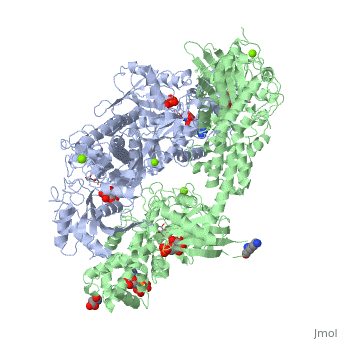Glycolysis Enzymes
From Proteopedia
(Difference between revisions)
| Line 10: | Line 10: | ||
==The fates of pyruvate== | ==The fates of pyruvate== | ||
| - | Under oxidative conditions, pyruvate continues to be metabolized through the [[The_Citric_Acid_Cycle|tricarboxylic acid cycle]]. While energy can be obtained under anaerobic conditions from glycolysis alone, the accumulation of pyruvate and NADH limits this. There are two main strategies for dealing with this problem. In most cells, [[Lactate_Dehydrogenase|lactate dehydrogenase]] converts the pyruvate and NADH to lactate, dealing with both problems at once and regenerating NAD+ so glycolysis can continue. Fortunately for us, some yeast cells do something else--leading to the generation of ethanol. First, [[ | + | Under oxidative conditions, pyruvate continues to be metabolized through the [[The_Citric_Acid_Cycle|tricarboxylic acid cycle]]. While energy can be obtained under anaerobic conditions from glycolysis alone, the accumulation of pyruvate and NADH limits this. There are two main strategies for dealing with this problem. In most cells, [[Lactate_Dehydrogenase|lactate dehydrogenase]] converts the pyruvate and NADH to lactate, dealing with both problems at once and regenerating NAD+ so glycolysis can continue. Fortunately for us, some yeast cells do something else--leading to the generation of ethanol. First, [[Pyruvate decarboxylase|pyruvate decarboxylase]] catalyzes the converstion from pyruvate to acetaldehyde, releasing carbon dioxide. Next, aldehyde dehydogenase reduces the acetaldehyde to ethanol, converting NADH to NAD+ in the process. |
==Additional Resources== | ==Additional Resources== | ||
Revision as of 11:26, 23 June 2022
| |||||||||||
References
Proteopedia Page Contributors and Editors (what is this?)
Alexander Berchansky, Ann Taylor, David Canner, Jaime Prilusky

